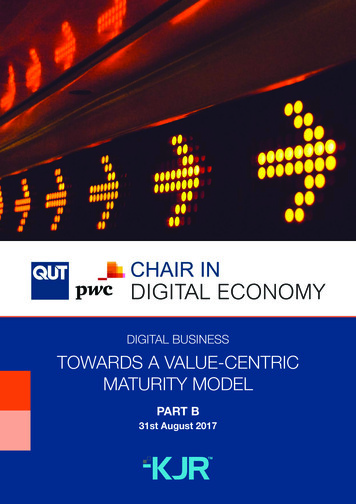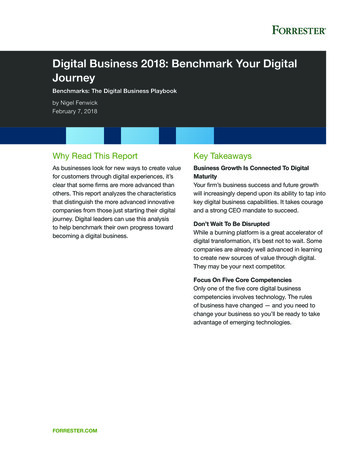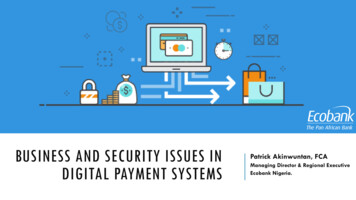
Transcription
DIGITAL BUSINESSTOWARDS A VALUE-CENTRICMATURITY MODELPART B31st August 2017
2.ACKNOWLEDGEMENTThe project was funded by KJR Pty Ltd and The Department of Science, InformationTechnology and Innovation, Australian Government, Australia. The authors would liketo extend sincerest thanks to Isobar Australia for their in-kind support in the project.Special thanks go to Sam Sterling, Sharon Behen, Natalia Traldi and Austin Miller fromIsobar Australia and Mark Pedersen, Andrew Coffey, John D’ Alton, Sarah Mercer fromKJR and other workshop participants for their feedback on the questionnaire.AUTHORSMd Shahiduzzaman, Marek Kowalkiewicz, Rowena Barrett and Matthew McNaughtonCONTRIBUTORSMark Pedersen from KJR Pty Ltd, Erin Hannan-Jones and Jodie Pattinson from PwC Chairin Digital Economy, QUT. PwC Chair in Digital EconomyThis publication does not necessarily reflect the views of PwC, Brisbane City Council, orQueensland Government.This document is the Comprehensive Report (Part B). An Executive Report (Part A) hasbeen prepared that provides summary of the findings.CRICOS 00213JThis report was funded and supported by
3.PREFACEThe business environment is rapidly changing and technology is shaping the wayorganisations can transform, gain and retain competitive advantage. Digital technologiesare enabling new ways of producing goods and offering services; identifying better waysto engage customers, employees and supply chains; improving operational efficiencyand fostering innovation. However, not all businesses are performing equally – some areembracing the opportunity, some are emerging, while still others are struggling to copewith the changes. What are the key attributes of a successful digital business and what arethe necessary steps to achieve success? Is technology, or perhaps leadership, strategyor culture the starting point? These questions have not been investigated in a systematicmanner, especially in the context of verifying and testing them with a combination ofacademic and practical rigour.This study provides a solution in the context. Following it will likely not only improve yourdigital capability, but also help generate higher returns on your investment and allow youto thrive in the digital economy.The Digital Maturity Model proposed in this report consists of six digital capability indicatorsand seven digital impact indicators. The maturity model has been developed throughextensive literature review, industry and expert panel consultation with academics andbusinesses. The model will help organisations run a successful digital transformation tocope with emerging challenges. The model will also help assess organisations’ progressin implementing these technologies, and assist management in identifying new pathwaysfor improvement and compare the progress with others.We hope your organisation will benefit from this maturity tthewMcNaughton
4.CONTENTSAcknowledgement 2Preface 3Emergence of digital business maturity model 5How does a maturity model work? 6How are maturity models used by business?7Defining digital concepts and impacts8Definition of a digital business 9Digital business examples 10Reflections of the overall economy 11Process behind the creation of the Digital Maturity Model13Introducing a digital maturity model to unlock innovation21Digital capability indicators 27Digital impact indicators 31The Digital Maturity Scorecard 34References 41Appendix A - Delphi Workshop 45
5.EMERGENCE OFDIGITAL BUSINESSMATURITY MODELAs the technological landscape is rapidlychanging, organisations must also transformor become victims of ‘digital Darwinism’[1].This has led to the emergence of theconcept of a ‘digital maturity model’ thatseeks to guide organisations in digitaltransformation.Digital transformation is defined as theprocess whereby a business becomesincreasingly digital over time by leveragingdigital technologies to provide new revenueand value-producing opportunities.This involves a complete integration oftechnology into all aspects of a business toimprove performance [2].A ‘digital maturity model’ can thereforebe defined as the extent to which a digitaltransformation process is explicitly defined,managed, measured and continuouslyimproved. The maturity level can beassessed in terms of measurable targetvalues that can be achieved in incrementalsteps [3].Since the early 1990s, a large number ofmaturity models have evolved [4, 5]. In asystematic mapping, Wendler [5] finds thatmaturity models are applicable to morethan 20 domains. These include softwareimprovement [see, 6, for a review of over 300articles], business process management [4],knowledge management [7], IT governance[8], IT alignment [9], risk management [10],project management [11] and so forth.However, most maturity models are domainspecific, considering one or more functionalor managerial attributes.There is a lack of research on organisationaloverviews of digital maturity models. Thegap in knowledge exists at both theoreticaland empirical fronts, particularly inevaluating and validating developed ‘digitalbusiness maturity models’.
6.HOW DOESA MATURITY MODEL WORK?Maturity models are based on the assumption of predictable patterns of evolution. Modelsusually include a sequence of levels (or stages) that together form an anticipated path froman initial state to optimal maturity [12, 13]. Maturity is assessed across several dimensionsthat together form the object of measurement.Accordingly, characteristics for each stage and the logical relationships between successivestages need to be explicated. In practice, the maturity levels indicate an organisation’scurrent (or desired) capabilities and provide improvement measures to achieve a greatermaturity [14,15].
7.HOW AREMATURITY MODELS USEDBY BUSINESS?Maturity models are used by managers in three key ways:DESCRIPTIVE USE To assess the ‘as-is’ state of particular organisational capabilities [12] As a diagnostic tool [16] To report maturity levels to internal and external stakeholdersPRESCRIPTIVE USE To identify desired maturity level and receive guidance on how to improve fromcurrent maturity level [12] To follow specific and detailed courses of action [16]COMPARATIVE USE To compare performance of the organisation through internal or externalbenchmarking [14, 16]
8.DEFININGDIGITALCONCEPTSAND IMPACTSThe starting point for developing a ‘Digital Business Maturity Model’ is todefine the term ‘digital business’.The concept of the ‘digital business’ is an evolution of earlier knowledge-basedbusinesses and is considered to be the driver of the Fourth Industrial Era.At its essence, it means to create or derive significant value in business basedon digital technologies [1].In a digital business, information technology is used in internal and externaloperations to create a competitive advantage [17]. In other words, digitalbusiness blurs the digital and physical worlds [18]. Given on the oppositepage are some formal definitions/characteristics of a digital business.
9.DEFINITIONS OF ADIGITAL BUSINESS A digital enterprise is “a company, irrespective of history or industry – whose ITplays a dominant role in the corporate strategy, i.e. where IT is used in internaland external operations to create a competitive advantage.” [17]. A digital firm is the one “where nearly all of the organisation’s significantbusiness relationships with customers, suppliers and employees aredigitally enabled and mediated. Core business processes are accomplishedthrough digital networks spanning the entire organisation or linking multipleorganisations.” [19]. “Digital Masters are companies that use digital technologies to drivesignificantly higher levels of profit, productivity and performance – these[companies] do exist, but they are rare” [20]. ‘Digitalisation’ or ‘to digitalise’ can be defined as “the use of digital technologiesto change a business model and provide new revenue and value-producingopportunities; it is the process of moving to a digital business” [18]. “Organisational change through the use of digital technologies and businessmodels to improve performance” [21]. “The integration of technology into all aspects of business in order to createfundamental changes in how they function and become more valuable to theircustomers (more than just getting rid of old technologies and adopting newones)” [22] Digital businesses improve customer experience, offer new digital products andservices, and digitalise internal processes [23]. Digital transformation is “a specialised type of business transformation where ITplays a dominant role. In the digital age, new business opportunities arise andenterprises transform their strategy, structure, culture and processes using thepotential and power of digital media and the internet” [17].The definitions above provide important characteristics of a digital business. Thesecharacteristics include strategy, digital network, technology capability, digitalisedbusiness process, new business model, organisational change, operational change,customer experience, digital products and services, structure, culture and so forth.The emerging consensus however is that ‘digital business’ is a people issue, whereorganisational ‘vision’ and ‘innovation culture’ drive digital transformation. We discussthese two aspects briefly over the page.
10.VISION ANDINNOVATIONCULTUREIN A DIGITAL BUSINESSVision refers to the long-term goal of anorganisation, which is the ultimate referencepoint of success of an organisation [24].Digital technologies, the pace and prevalenceof these, are forcing organisations to reimagine business models, change process,upgrade technology, and improve productsand services [25]. These changes, whilebringing plenty of promising opportunities,pose a plethora of challenges to navigatethrough the transformation process.A vision is a ‘wayfinder’ in the contextmeaning that the transformation requiresto be ‘purpose driven’. A digitally matureorganisation should have a clearlyarticulated vision and design strategies andcourses of actions accordingly to achievethe goal.Technology is seen as a strong ‘driver’ and‘enabler’ in the transformation, however,unless there is a significant amount ofhuman efforts to understand the core (i.e.,purpose) on the changes, nothing can begained [26].The second human effort every digitallymatured organisation needs is to have a‘culture of innovation’. In the age of intensecompetition, massive disruption and hyperchanges, organisations that are agile cansurvive and organisations that are innovativecan thrive. Innovation can lead the creationof new business models, improve businessprocess or explore new markets [1, 27].However, in order to achieve innovationpotential, organisations need to invest timeand resources to embed an innovative andagile culture – ‘the capability of the entireorganisation to perceive, think and react toits various environments in a timely manner’[28, 29].In a digitally mature organisation, bothvision and culture sit together to generatevalue from the transformation process.Digital businesses benefit from a diverseresource base, an innovative culture, aclear vision, and how in the contemporaryenvironment digital technology supports thetransformation process.DIGITAL BUSINESSEXAMPLESWhen we think of digital organisations anumber of examples come to mind likeAmazon.com, Apple, Facebook, Google andNetflix.
11.While some of these organisations wereborn digital (e.g. Facebook & Google), themajority of digital organisations began asanalogue and have re-imagined themselvesin the digital world.An example of this is the US companyNetflix, which started as a DVD mail rentalbusiness in 1997. In 2007, Netflix expandedits business with the introduction ofstreaming media, while retaining the DVDand Blu-ray rental service. Netflix took itsstreaming service international in 2010starting with Canada, and now operates inover 190 countries.Therefore, in order to be a digitally matureorganisation, the business does notnecessarily have to be born digital, butmust have the ability to reimagine itselfin the digital world. This is where vision,innovation and technology support eachother.REFLECTIONS OF THEOVERALL ECONOMYSo how do examples of digital masters (likeGoogle, Facebook and Apple) fit into thecontext of other small and medium sizedbusinesses in the new economy?In the last two years, the Chair in DigitalEconomy has been working closely withsmall and Medium Scale Enterprises (SMEs)in Queensland [30]. Our research indicatesthat while the use of technology variesacross SMEs, most successful businesseshave the ability to apply technology in aninnovative way to provide unique product/service to customers. For example, firmshaving produced itself either a piece oftechnology or a distinct application oftechnology to the production process.Technologies play a key role in themanufacturing process and the product istherefore different to all similar productsbecause of the distinctive ways in which themanufacturing technology is constructedand applied. As the owner of a successfulmanufacturing firm puts it, “[in the factory]there’s sensors and belts that turn off andon again all linked to the computer andphone so [owner 2] can monitor productionand change settings to ensure high qualityis produced ” [30] p 20].Similarly, for a successful services firm,the way technology is combined at thisfirm to create a holistic energy system andcustomer solution underpins their growth.An engineer at the services firm describedit as:“.the systems are quite sophisticated with theirbattery management capabilities: they have datalogs, fault logs and all kinds of things like that. Weprogram the system from a huge range of settingsand we have the ability to download and seeexactly how it has been operating. Every minuteis logged so we know exactly what load is beingapplied as well as how much electricity is beinggenerated at any point in time. So we know moreabout the performance of the system than theowners do” [30] p 20.”
csf12.What this means is that these firmsare able to have useful conversationswith their customers and troubleshootproblems quickly and easily.Successful firms in the digital age arenot the firms that are relevant within adigital silo, but the firms who are able toimplement digital at the organisationallevel. Technology can lead firms tosuccess only when a firm has a greatproduct or a compelling problem tosolve. Similarly, the culture of the wholeorganisation is to embrace change andoffer better services and products tocustomers in a timely manner.Our ‘Digital Maturity Model’ is likelyto help businesses to grow, sustainand leverage opportunities from thetransformation process.We describe Digital Maturity as the process wherebya business becomes increasingly digital over time byleveraging new digital technologies to provide new revenueand value producing opportunities [1, 17, 21, 31].
13.PROCESS BEHIND THE CREATION OFTHIS DIGITALMATURITYMODELLITERATUREREVIEWA literature review wasconducted to understandorganisational maturitymodels, their dimensionsand the process that shouldbe undertaken to create anew digital maturity model.By understanding the intentof other models, we canidentify the gap in currentresearch.DELPHI WORKSHOPWITH CONTENTMATTER EXPERTSIDEATIONWORKSHOP WITHINDUSTRYThe Delphi method is acommunication methodto get feedback on aquestionnaire from a panelof experts.Industry participation hasbeen pivotal in the cocreation of this digitalmaturity model.In this method expertsprovide feedback onquestionnaires and theresponses from them areaggregated and shared withthe group after each round.An ideation workshop wasorganised with two leadingdigital consultancies to testthe usability and efficacyof the questions whichdetermine digital maturityof an organisation.
14.LITERATUREREVIEWBUILDING THEFRAMEWORKThe first phase of development was toundertake a comprehensive literature review.The purpose of this review was to providecritical analysis of published sources onmaturity model development and answerthe following research questions:KEY FINDINGSMATURITY MODEL DIMENSIONSOur literature review identifies existingmaturity models in the following domainsthat may be relevant to our model basedon the potential digital maturity dimensionslisted below (with key references in theparenthesis).The following maturity models wereidentified as being relevant: Business process management(BPM) [32-34]1. What is the process for maturitymodel creation? Leadership, OrganisationalLeadership [20, 34]2. What are major components ofdigital transformation? Risk management [35, 36] Digital business transformation [1,17, 37]3. What are the classification criteria ofa maturity dimension that should beincorporated in the present model? IT functions/IT alignment [9, 38]This phase was undertaken through desktopresearch. IT governance (organisationalleadership & culture)[39, 40]SCOPING Knowledge management/ Innovationmanagement [7, 41, 42]To narrow the scope of the review, thefollowing databases were used for research:Google, Google Scholar and QUT OnlineLibrary. Searches were limited to findarticles from peer-reviewed journals andbooks. Figure 1 shows the alternativesearch terms to find appropriate literature. Software improvement/Engineeringprocess ([42, 43] User experience (UX) [44, 45]Maturity dimensions are the specific,measureable and independent elementsLITERATURE REVIEW SEARCH TERMS: FIGURE 1Define/Defining/Definition DigitalDigital organisationDigital organizationDigital maturityDigital immaturityDigital companyDigital businessAttributes DigitalOrganisations digital economyTransition to DigitalAnalog v DigitalDigital transformationMaturity ModelMaturity Model Development
15.which reflect the fundamental componentsof maturity in a given business area(Domain) [14]. Each of these maturitymodels uses a structured collection ofdimensions that describe the characteristicsof effective processes at different stagesof development. These dimensions havebeen used in generating a framework forthis project.MATURITY MODEL ATTRIBUTESThere are different attributes of the existingmaturity models. These can be dividedinto three broad categories: Technologyand Integration; People and Management;and Product and Service. These are brieflydiscussed below.TECHNOLOGY AND INTEGRATIONThe first aspect of Digital Transformationthis model will analyse is Technology andIntegration. This refers to an organisation’suse and adoption of new digital technologiesand their integration with existing legacysystems.Breakthrough Digital TechnologiesDigitisation is driven and enabled bytechnology breakthroughs [46, 47].These technologies have an increasinglywide reach and dissemination and aretransforming the way industries operate[1, 48]. These technologies are pushingboundaries and leveraging scale to witness“an era unmatched in the history of businessinnovation and transformation’[1].These breakthroughs occurs due to Moore’slaw and Metcalfe’s law, suggesting thattechnology capabilities are evolving at anexponential pace. In order to cope with thechanges, Digitally mature organisationscan respond effectively and quickly to newtechnologies [49].Existing Technology/Legacy TechnologyThe existence of legacy technology can bea barrier to digital maturity as it can createproblems when it takes significant time,energy and expense to change [49]. Legacytechnology may be considered a risk factorTABLE 1 [MATURITY DIMENSIONS AND INITIAL SOURCES]MATURITY DIMENSIONSTechnology FoundationINITIAL SOURCE(Fitzgerald, Kruschwitz, Bonnet, & Welch, 2014) (Soule& Westerman, 2016) (Marchand & Wade, 2014) (Ross etal., 2016) (Kane, Palmer, Phillips, Kiron, & Buckley, 2015)(Gimpel & Röglinger, 2015) (Oswald & Kleinemeier, 2017)People and Management(Fitzgerald et al., 2014) (Kane et al., 2015) (Keen &Williams, 2013) (Faeste, Gumsheimer, & Scherer, 2015)(Marshall, 2017) (Marchand & Wade, 2014) (Ross etal., 2016) (Soule & Westerman, 2016) (Kohnke, 2017)(McAfee & Welch, 2013) (McAfee & Welch, 2013; Oswald& Kleinemeier, 2017)Customer Centricity(Fitzgerald et al., 2014) (Soule & Westerman, 2016)(Ross et al., 2016) (Berman, 2012) (Oswald &Kleinemeier, 2017)
16.within the maturity model. The model mayalso address how well the organisationintegrates new technologies with old.Objects of Digital Technologies [47]Digitally ‘mature’ firms use digitaltechnologies to achieve the followingpurposes: Digitalised Operations (process andwork) Product and services. Business ModelsThe model should assess where digitaltechnologies are in use in the organisationand how they are being used. Key indicatorsof technology adoption include funding newtechnology adequately, effective integrationof new and old systems [49], integrationof all customer touch-points including thedigital and physical channels, digitallyenabled supply chains [50] and re-imaginenew business models, products or services.assets is not enough on its own to sustaina competitive advantage. Rather, it isan organisation’s ability to successfullyleverage digital technologies throughdigital capabilities that is a strategicdifferentiator [52]. This means that withoutcapabilities supporting the adoption of newtechnologies, there is no certainty that theshift will create value for an organisation[53].This is why our maturity model has drawnthe single concept of ‘Digital Capability’which covers both technology and ‘peoplecentric’ elements of the organisation.Capabilities of Digitally ‘Mature’OrganisationsAnalysis of the literature reveals that digitally‘mature’ organisations tend to have thefollowing digital capabilities (competenceareas);1.A clear, coherent and well developedstrategy for how digital will beincorporated into business;2.Leadership, management andgovernance that supports itsstrategy;3.Investment in digital knowledge,skills and competencies to realise itsstrategy; and4.A proactive culture that embracesinnovation.People and ManagementRecent studies highlight the criticalimportance of a company’s ‘peopleand management’ for effective digitaltransformation [51]. These aspects of digitalcapabilities are found in an organisation’sleadership, strategy, processes, people,skills, business models, structure,governance, and culture [1]. A company’sdigital capabilities are distinct from itsdigital assets.Digital Assets versus Digital CapabilitiesDigital technology as a source ofcompetitive advantage encompasses bothdigital assets (e.g. hardware, software) anddigital capabilities (e.g. managerial skills,strategy).The implementation of tangible digitalThese capabilities complement one another,and in tandem allow a business to achievethe highest level of digital maturity [54].Each capability may be further broken downinto competence categories. Analysis ofhow each of these competence categoriesare managed by an organisation willreveal its pathway towards ‘people andmanagement’ digital maturity.
17.PRODUCT AND SERVICEThe final aspect of a maturity model is theoutward, ‘final product/service’ aspect ofdigital transformation. As consumers are theend beneficiaries of digital transformation[1] an organisation’s ability to adapt andrespond to their needs is the third crucialaspect of digital maturity [46].TECHNOLOGY AS A PRODUCTThe concept of maturity model initiatedwith the concept of quality managementof software process [43, 55, 56], withthe Capability Maturity Model (and itsderivatives) being a dominant example in thesoftware engineering domain. These modelsrecommend a path to improve the softwareprocess capability of an organisation, butthe majority of them provide a processcentric approach to improvement ratherthan organisational view of digital maturity.TECHNOLOGY AS A SERVICETechnological advances and morewidespread dissemination of data andinformation have given rise to a moreempowered global consumer. Customersnow have real-time access to competitiveprice tags or peer reviews on products thatallow them to make informed choices.Customers expect to be able to accessinformation about the company and itsproducts at any time from any device for anypurpose [1]. Digitisation (mobile and socialtechnologies) also gives businesses newopportunities to interact with customers.For example, social networks can be usedto listen and to better understand customeropinions.These technologies can also be used forcommunicating with customers to providebetter customer services[1]. There is agrowing expectation to provide services inreal-time manner ( 24/7) or even to deliverservice proactively before they ask for theservice (knowing that the customers willneed it).Organisations need to understand whichof their business models, processes andinteractions with customers have to changeto be effective in a digital world, and whichwill continue to be effective [1]. They cando this using tools to understand theimplications of digital transformation fordifferent stakeholder groups. These toolsinclude: Change impact analysis [57] Customer journey map (describescustomers’ expectations,experiences and reflections as itunfolds over time across multiplestages and touch points while usinga product or consuming a service)[58]Oswald recommends focusing on the customerjourney to ground the digital transformation inthe practical realities of change by maintaininga strong customer orientation [1] [59]. Aftermapping the customer journey, organisationscan focus on how the rapidly evolving digitaltechnologies can make touch points better,faster and more efficient [59].To sum up, a digital business maturity modelshould be comprehensive enough to captureall three attributes, i.e., Technology andIntegration; People and Management; Productand Service as discussed above. Existingliterature provides guidance to identifycapabilities across these attributes.
18.DELPHI THE FOLLOWINGDISCUSSION POINTS ANDWORKSHOPCONSENSUSES AROSE INTHEORETICAL THE WORKSHOPCONSENSUS1. HOW DO WE DEFINE MATURITY?From the review of the literature wetentatively identified a number of capabilitiesthat could be measured to assess anorganisation’s progression towards digitalmaturity (Appendix A, Handout 2). In thisphase of research, the Delphi technique wasused to verify and challenge these identifiedcapabilities.The Delphi technique is a widely used andaccepted method for consensus-buildingamong a panel of experts. Panelists areselected based upon their expertise,somewhat related backgrounds andexperiences concerning the target issue,capable of contributing helpful inputs, andare willing to revise their initial judgementsfor the purpose of reaching consensus [60,61].THE DELPHI PROCESSSubject matter experts were selected from awide range of disciplines and backgroundsincluding IT, economics, engineeringand business. The experts were broughttogether for a workshop where they wereeach given a list of 32 business capabilitiesand definitions. The experts were thenasked to individually rate importance ofincluding each of the dimensions in thematurity model. After the experts hadcompleted this activity individually, thegroup came together to build consensus.The discussion began with a generalconsensus that it is essential to have asound working definition of maturity.For example, should maturity be defined ashaving good returns on investment? If thatis the case, then maturity is only achievablewith a good understanding of product andcustomers from the inside and this shouldbe included in the model.On the other hand, if maturity is measuredon a scale from non-digitally nativecompany against digital native companythen these businesses will have opposingorganisational structures and this will needto be reflected in the model.2. WHAT ARE THE KEY CAPABILITIES OFDIGITALLY MATURE ORGANISATIONS?There was a general consensus among thepanel that digital leadership is one of themost important capabilities of a digitallymature organisation. This implies funding,culture and influence towards digitalinitiative.The group also agreed that management,accountability and training are essentialcapabilities to support leadership. Thesecond most important capability discussedwas the ability of the organisation toinnovate. The panelists discussed thatthis would include capabilities such asculture, design thinking, problem handling,governance, risk tolerance/appetite and riskmanagement.
19.3. TECHNOLOGY ALONE IS NOT AN INDICATOR OF MATURITY.There was a strong consensus among the panelists that technology on its own is notsufficient to be an indicator of digital maturity. The panelists discussed that maturity ismore about business awareness of HOW, WHY and WHEN particular technologies shouldbe used. The amount of technology in use in businesses will also vary from sector to sector.The panelists also discussed that knowledge management is crucial in terms of businessesbeing able to conduct cost/benefit analysis to implement or outsource new technology.The insights gained in the Delphi workshop were then used to create a ‘Draft’ digital maturitymodel that was tested in the next research phase.Image #1 - Expert panel reaching consensus
20.PILOTINGAND TESTINGTHROUGHONE-ON-ONEINTERVIEWSWITH INDUSTRYSTAKEHOLDERSACTIVITIESThe industry workshop commenced with anintroduction to the thinking and literaturereview that had informed the design anddevelopment of the Digital Maturity Model.MAPPING THE GAPS - COMPLETE THEQUESTIONAIRE WITH ROLE PLAYThe thinking behind this activity was forparticipants to assume the role of theirclients to complete the questionnairefrom start to finish without assistance. Asthis was being conducted, participantswere asked to write on post-it notes, whatdoesn’t make sense and what gaps exist inthe questions and framework.IDEATION - SOLVING IDENTIFIED ISSUESAs pr
MATURITY MODEL. PART B. 31st August 2017. . knowledge management [7], IT governance [8], IT alignment [9], risk management [10], . to change a business model and provide new revenue and value-producing opportunities; it is the process of moving to a digital business" [18].










